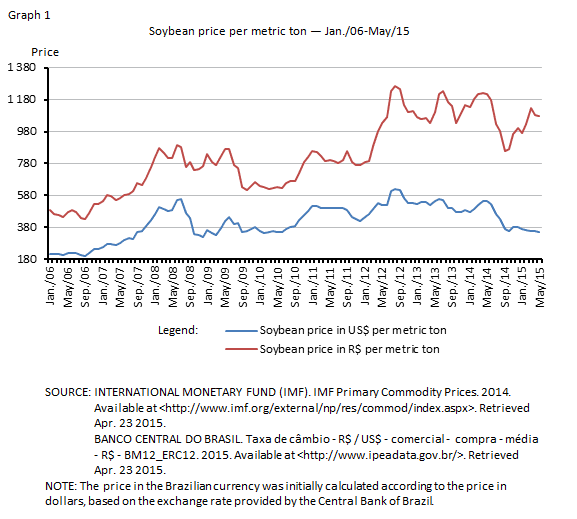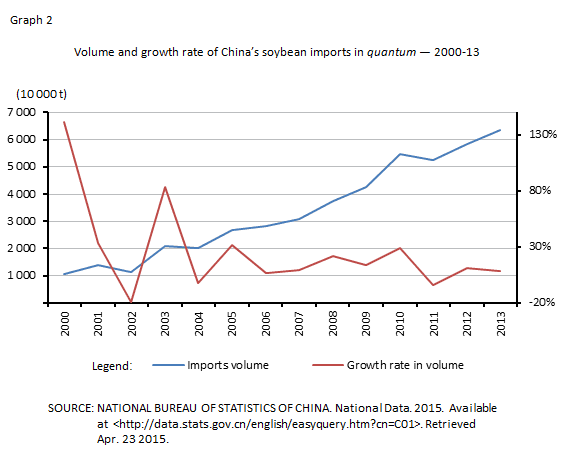China has been undergoing profound economic and social transformations. The industrialization that has taken place in the last few decades, as well as the growing urbanization, have increased the demand for food and have been impelling the country to become increasingly concerned with its food security. Due to its land structure, much of the Chinese countryside still struggles to expand its crops through the economy of scale derived from technological modernization. This fact, along with environmental problems, such as pollution and water scarcity, has led China to reform its agricultural policies as well as seek international alliances related to agribusiness. However, even at a significantly higher cost, China has managed to maintain adequate levels of food self-sufficiency (above 95%).1 In that context, we can glimpse opportunities for Brazil which may help to implement strategies aimed at an international trade more qualified and more integrated with the main chains of Chinese agribusiness.
It is quite common to characterize China as a country of superlative dimensions and, in the case of agriculture, this pattern is also valid. Among the crops that are significant for Brazil, the Asian nation is the world’s largest producer of rice and tobacco, the second largest producer of wheat and corn and the fourth largest producer of soybeans. In the early 2000s, China’s entry into the World Trade Organization (WTO) allowed the country to increase its participation in the global trade of agricultural products. Between 2001 and 2008, the exports and imports of these products grew, respectively, by 170% and 225%.2 During this period, China reversed its trade balance in order to ensure the internal availability of food, moving from exporter to importer of this product. Despite the growth of food production and imports, changes in habits resulting from rapid urbanization has had a negative impact on the nutritional value of the Chinese farmers’ diet. Recent analysis3 on the intake of nutrients by rural populations in 30 Chinese regions4 between 1998 and 2010 concluded that their expenditures on non-food products and maintenance of their rural properties contributed to the reduction in their consumption of calories and proteins.
Another point to highlight is that only in 2008 most of the world’s population became predominantly urban. This change was perceived a few decades ago in the industrialized countries, but only in recent years it has become a reality for some developing countries. The Brazilian population ceased to be predominantly rural in 1964, while in China the same phenomenon occurred only in 2011. Currently, in 12 out of the 31 regions of China the population is predominantly rural.5 The recent and intense Chinese rural exodus has led to the drainage of the workforce to the industrial sector, which may have contributed to a relative loss of agricultural vitality in the country.6 Migration from the countryside to urban settlements has resulted in complex urban and rural social problems. In the countryside, for example, there is an apprehension about the significant number of elderly people and children who have not taken part in the rural exodus. These are called by the specialized literature the “left behind” contingent. The Chinese government has shown concern about reducing the divergence in the per capita income between urban and rural populations as a way to extenuate the driving forces of a rural flight with no effective economic and geographic sense. It has also been seeking ways to indirectly increase the incomes of farmers, mainly through public services related to education and health, as well as investments in road infrastructure in rural areas.
Objectives such as bridging the gap between rural and urban life as well as promoting the modernization of Chinese agriculture are key elements of the New Socialist Countryside7, implemented in the 2000s by the Chinese Central Government. Another aspect that suggests that there is great concern about the situation in the Chinese countryside is the content of the 13th Five-Year Plan, which was launched in March of 2016 and will guide the nation’s course until 2020. After each five-year plan, the pattern of economic growth induced by exports and based on land, labor and investments is being gradually replaced by the adoption of a new paradigm of development oriented to the domestic consumption.
The current five-year plan contains a series of instruments that seek to not only increase incomes in the countryside and to modernize agriculture in an ecologically sustainable way, but also promote the controlled urbanization of certain regions, especially in the northwest, by extending urban residence permits (Hukou). The plan also seeks to give a new migratory meaning to the already saturated east coast, where migrants generally work in precarious conditions and without basic social rights. This demographic flow will have allowed 100 million rural Chinese citizens to settle down in cities by 2020.8 The migratory flow is likely to replicate some patterns already verified in contemporary China for this type of transition, mainly in terms of the westernization of the Chinese eating habits. This way, it can be inferred that during this period there will be a greater demand for processed foods, meat and dairy products and also for meals outside the household.
The increase in the income of rural workers through the adoption of public policies, notably agricultural subsidies, may affect the international price of food, especially when the policy is applied by a large country such as China. In 2000, subsidies represented 2.77% of all Chinese agricultural income, rising to 21.34% in 2015.9 However, China has encountered resistance to the continuation of this subsidy policy. On September 13, 2016, the United States notified the WTO of the initiation of litigation procedures against China regarding its domestic support measures for the agricultural sector. The measures involve subsidies granted by China, especially on wheat, rice and corn.10
Currently, agricultural subsidies take various forms and can be granted to producers as a counterpart of agricultural production or as a guarantee of a basic agricultural income, regardless of the crops harvested. When, for instance, a government guarantees the purchase of a share of the crops and sets minimum prices, depending on the country’s crop size, this policy can generate a series of distortions in international trade and in the global geography of agriculture. Because this type of policy distorts trade, less fertile land can be used, which can proportionally increase world demand for fertilizers and agrochemicals. According to some studies, international food trade must incorporate, in addition to monetary values, the amount of land and water implicit in these transactions. It is argued that an effectively globalized agriculture may optimize the use of natural resources in the world.11
In the case of China, the policies of minimum prices and government purchases have posed problems for the country’s central administration. In addition to frequent questions about the quality of its stocks, the administrative difficulty of storing increasing amounts of grains is latent. As regards corn, for example, the stock equals that of the annual Brazilian production. Given the gigantism related to almost everything in China, this problem, apparently restricted to the country, has generated uncertainties about the actual food needs in China, reflected in international price volatility and pressure on the agricultural frontiers of its trading partners.
In conclusion, it should be noted that the magnitude and rapid growth of the Chinese market are in themselves good reasons for the Brazilian public and private sectors, especially those related to agribusiness, to remain attentive to China’s economic and social reality. That country has demonstrated competence in the task of ensuring food security and sound levels of self-sufficiency over the last few years. Brazil, an indispensable trading partner for China, needs to have deep knowledge of that country’s rural reality, as it is quite likely that the best opportunities will emerge from shortcomings in the Chinese plans for this sector. The Chinese, careful and pragmatic in their decisions, have sought to ensure that Brazil is able to continue providing its necessary quota for China’s food security. This is suggested, for example, by recent investments in Brazil by the Chinese state food company Cofco. Protocols of intention to invest in Brazilian infrastructure also denote China’s concern over Brazil’s requirements to remain an indispensable and strategic partner.
It is likely that China will be forced to reallocate the subsidies so as to fit them into the so-called “Green Box”, a WTO classification for measures that create minimal impacts on prices and international trade. It took many years for the European Union and the United States to adapt their subsidies to the Green Box. Brazil, a country with a leading role in the WTO, even opposing the subsidy policy, has the potential to be an ally of China in this regard, mainly due to the similarities related to rural poverty in the two countries. Therefore, every form of high-level relationship, such as the BRICS group — Brazil, Russia, India, China and South Africa — should be used sagaciously by Brazil. China is unlikely to break the WTO rules, but it may need strong partners so that the agricultural negotiations in that institution do not force it to absorb undesirable external constraints on its domestic plan.
Another possible opportunity that may arise for the Brazilian agribusiness is related to the costs inherent to the ecologically sustainable and low carbon agricultural production proposed by the current Chinese five-year plan. The agricultural expansion China needs to meet its growing demand, as well as changes in the Chinese eating habits resulting from urbanization and rising income, will require even more of its scarce natural resources, notably water and arable land. Brazil is able to produce this additional quota of food for the Chinese people at a significantly lower environmental cost.
1 FIGUEIREDO, E. V. C; CONTINI, E. China gigante também na agricultura. Revista de Política Agrícola, n. 2, p. 5‑30, abr./jun. 2013.
2 CARTER, C. A.; ZHONG, F.; ZHU, J.. Advances in Chinese agriculture and its global implications.
Applied Economic Perspectives and Policy, v. 34, n. 1, p. 1-36, 2012.
3XU, Z.; ZHANG, W., Commodification and westernization: explaining declining nutritional intake in contemporary rural China. Journal of Agrarian Change, v. 15, p. 433–453, 2015.
4Provinces, autonomous regions and municipalities.
5 CHINA STATISTICAL YEARBOOK. Proportion of urban population at year-end by region. [2015]. Retrieved from <http://www.stats.gov.cn/tjsj/ndsj/2015/html/EN0206.jpg> on Dec. 2, 2016.
6 ZHANG, Q. F.; OYA, C.; YE, J.. Bringing agriculture back in: the central place of agrarian change in rural China studies. Journal of Agrarian Change , v. 15, p. 299–313, 2015.
7 AHLERS ,A. L.; SCHUBERT, G.. Building a new socialist countryside — only a political slogan? Journal of Current
Chinese Affairs , v. 38. n. 4, 2009.
8 NATIONAL PEOPLE’S CONGRESS OF CHINA. China’s NPC approves 13th Five-Year Plan, n. 1, p. 23, 2016. Retrieved from <www.npc.gov.cn/npc/zgrdzz/site1/20160429/0021861abd66188d449902.pdf > on Dec. 4, 2016.
9In 2000, US, European Union and Brazilian subsides represented, respectively, 22.66%, 32.87% and 5.73% of overall domestic agricultural revenues. In 2015, the figures were 9.44% (US), 18.92% (EU) and 2.57% (Brazil). ORGANISATION FOR ECONOMIC CO-OPERATION AND DEVELOPMENT (OECD). Producer and consumer support estimates database. 2016. Retrieved from <www.oecd.org/tad/agricultural-policies/producerandconsumersupportestimatesdatabase.htm#country > on Dec. 1, 2016.
10WORLD TRADE ORGANISATION (WTO). United States files dispute challenging Chinese agricultural subsidies. 2016. Retrieved from <www.wto.org/english/news_e/news16_e/ds511rfc_14sep16_e.htm> on Dec. 1, 2016.
11MACDONALD, G. K.; BRAUMAN, K. A.; SUN, S., CARLSON, K. M.; CASSIDY, E. S.; GERBER, J. S.; WEST, P. C.. Rethinking agricultural trade relationships in an era of globalization.Bioscience, v. 65, n. 3, pp. 275–289, 2015.


